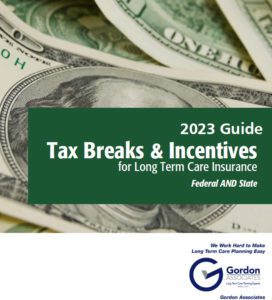Your health is unique. And that remains true as you age. As a result, long term care is highly individualized, both in terms of the care you need and when you need it. Long term care can quickly become complex–and so too can the Long Term Care Insurance Policy. Both benefits and drawbacks can hide in these wrinkles of complexity; if you don’t know what you’re looking for, you may end up with a policy that isn’t suited to your needs.
That’s why having an experienced LTCI agent on your side is incredibly helpful while you’re shopping for the right plan. Ideally, you and your agent will become partners as you search.
This partnership, however, is only as good as your agent. A great LTCI agent should absolutely rip apart your policy before you buy it–looking under the hood to make sure it’s suited for your lifestyle, your goals, and your healthcare needs.
How Do We Examine Policies?
At Gordon Associates Long Term Care Planning, we have decades of experience helping clients choose the policy that best suits their needs. We walk through specifics with clients to make sure all the ins and outs work best for your goals. This requires taking some educated guesses (after all, your needs will likely change over a ten year period–or longer), but it’s also why working with an experienced LTCI agent is essential.
Here are some of the factors that we look for in LTCI policies of our clients.
Which Policy Type is Right For You
A thorough agent is going to present multiple types of plans to you, since LTCI is not a one-size-fits-all product. One of our previous blogs addresses this in detail, so we will just cover the basics to get started:
Stand-Alone LTCI is known as Traditional LTCI coverage, which only pays out benefits during claim time. It’s often thought of as a use it or lose it type of plan. These policies typically come with lifetime premiums, which are subject to rate increases (although there is one Stand-Alone carrier that Gordon Associates works with that offers a guaranteed 10 pay paid-up policy).
Hybrid Asset-Based Life/LTCI policies offer a guaranteed payout of LTCI benefits or life insurance left for your heirs. These plans also come with guaranteed premiums (will never increase or change) and have multiple payment options (Single Pay and 10 Pay for example – not available in all cases).
How the Carrier Pays Out Benefits
How your benefits are paid out during claim time is essential when planning the future. Some of the carriers offer a reimbursement model and others offer a cash indemnity model. Here are the key facts you need to be aware of:
Reimbursement plans
- Once a client is benefit eligible, approved for claim, and has met their elimination/deductible period, the carrier will reimburse for services received, up to the max benefit available under the plan.
- These plans require invoices/receipts (and often a specific form from the carrier).
- A licensed caregiver is required.
- If your max benefit available is more than your case costs, this can extend the life of your policy.
Cash Indemnity plans
- Once a client is benefit eligible, approved for claim, and has met their elimination/deductible period, the carrier will pay out the max benefit available under the plan.
- There are no receipts/invoices required.
- You can hire any caregiver you like (licensed, non-licensed, or even a family member).
- If the max benefit you receive is more than your care costs, you can do whatever you want with the extra funds (save, invest, pay bills, etc.).
Experienced agents will present you with both options so you can determine what makes the most sense for your situation.
Travel limitations
Some policies are locked to a specific region or country. You might not think this is a big deal at first–but if you want to move out of the country and your policy is USA-only, you’ll have a problem when you decide to activate your policy. That’s why we look for this for our clients–and talk about future travel plans.
Calendar vs. Service Day Elimination Period
In the world of Long Term Care Insurance, your elimination period is kind of like your deductible. It’s the time period during which you have to pay for everything out of pocket before your benefits kick in. There are two basic models of elimination periods:
- Service days: A “service day” has 2 components: 1) you need the help from an outside service, and 2) that service qualifies as a “service provider” under your policy. Not all do. Only days where you meet those requirements count toward your elimination period. For example, if you’re at home and need care 3 days a week, using a homecare agency that qualifies counts. You are required to pay for healthcare services on a specific number of days (maybe it’s 30 days, maybe it’s 90–it depends on your policy). Once you have paid for that number of service days, your benefits will kick in. So, it might take you longer than, say, 90 days to use up your 90 day elimination period.
- Calendar Days: This type is a little easier to understand. Once you activate your policy, a specific number of calendar days (90 is a common one) must pass before your benefits activate. This type of elimination period is typically easier for clients to plan for.
Knowing which type of elimination period your plan uses is essential to good care planning.
Daily vs. Monthly Benefit
When agents look at plans, they will often examine the benefit type. Most plans introduce either a daily or monthly benefit. Neither is necessarily better than the other–but it’s important to know which one your policy includes, so you can plan accordingly. There are two basic types:
- Per day rate: For example, you might have a benefit that pays out at $200/day
- Per month rate: Or your benefit might pay out monthly. For example, $6,000/month.
At first glance, it might seem as though both of these example policies would pay out in equal terms. However, it may not work that way in practice. For example, if you needed 15 days of care–and that care costs $6,000–the per month rate would cover your expenses but the per day rate ($200/day * 14 days = $2,800) would not. The more you know about the shape of your policy benefit type, the better prepared you’ll be for your long term care needs.
Information is Power
If you aren’t immersed in the world of Long Term Care Insurance (and most people aren’t), it might be hard to keep track of all these considerations when you’re purchasing your own LTCI plan. And getting stuck with a plan that’s not right for you can mean your long term care is more expensive than you planned. That’s why it’s often critical to work with a trusted, experienced agent.
In many of these cases, there’s no such thing as universally “good” or “bad” options. It’s about finding the option that works best for you–and know what the benefits and drawbacks of that plan are early in the process.
Uf you want to avoid unwelcome surprises, contact us today to schedule an appointment!


 To help determine if long-term care (LTC) insurance is right for you, we are offering a FREE informational guide. This is a comprehensive booklet that will answer many of your questions about tax breaks and incentives for LTCI for federal and state taxes.
To help determine if long-term care (LTC) insurance is right for you, we are offering a FREE informational guide. This is a comprehensive booklet that will answer many of your questions about tax breaks and incentives for LTCI for federal and state taxes. To help determine if long-term care (LTC) insurance is right for you, we are offering a FREE informational guide. This is a comprehensive booklet that will answer many of your questions about LTC and assist you with your health care planning.
To help determine if long-term care (LTC) insurance is right for you, we are offering a FREE informational guide. This is a comprehensive booklet that will answer many of your questions about LTC and assist you with your health care planning.